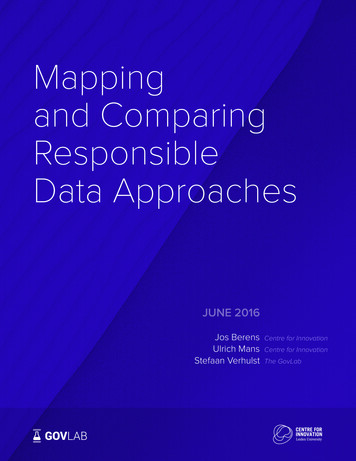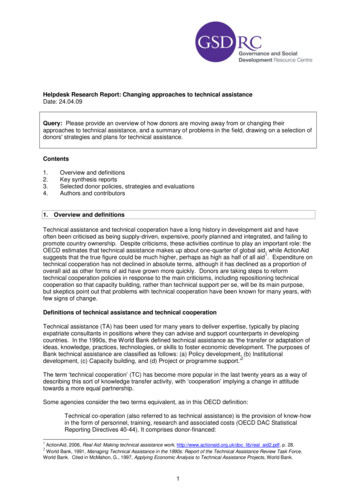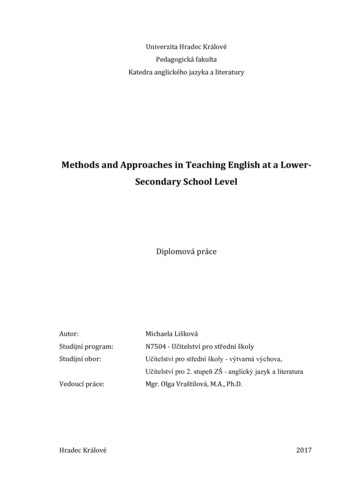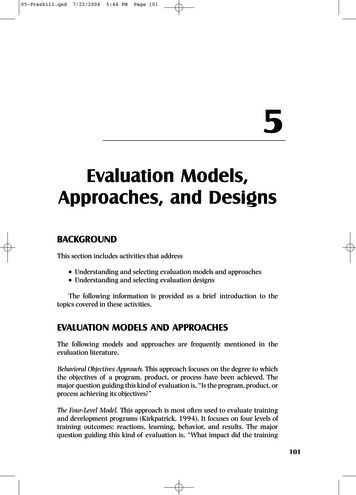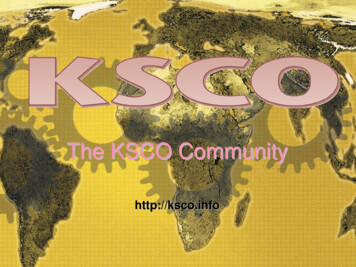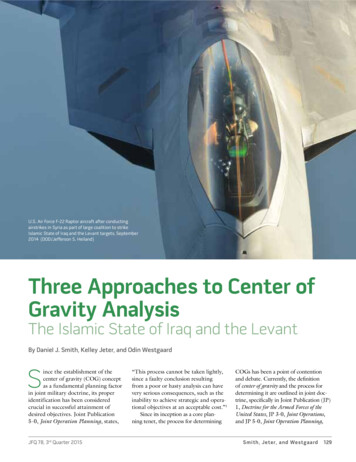
Transcription
U.S. Air Force F-22 Raptor aircraft after conductingairstrikes in Syria as part of large coalition to strikeIslamic State of Iraq and the Levant targets, September2014 (DOD/Jefferson S. Heiland)Three Approaches to Center ofGravity AnalysisThe Islamic State of Iraq and the LevantBy Daniel J. Smith, Kelley Jeter, and Odin Westgaardince the establishment of thecenter of gravity (COG) conceptas a fundamental planning factorin joint military doctrine, its properidentification has been consideredcrucial in successful attainment ofdesired objectives. Joint Publication5-0, Joint Operation Planning, states,SJFQ 78, 3rd Quarter 2015“This process cannot be taken lightly,since a faulty conclusion resultingfrom a poor or hasty analysis can havevery serious consequences, such as theinability to achieve strategic and operational objectives at an acceptable cost.”1Since its inception as a core planning tenet, the process for determiningCOGs has been a point of contentionand debate. Currently, the definitionof center of gravity and the process fordetermining it are outlined in joint doctrine, specifically in Joint Publication (JP)1, Doctrine for the Armed Forces of theUnited States, JP 3-0, Joint Operations,and JP 5-0, Joint Operation Planning,Smith, Jeter, and Westgaard129
as encompassed in the Joint OperationPlanning Process (JOPP) within thosepublications. Speculation on properCOG determination has given rise toother COG methodologies, which haveboth questioned and challenged established doctrine for COG determination.Therefore, the objective of this article isto compare and contrast different COGdetermination methodologies to revealstrengths and weaknesses of each andultimately to make recommendations forchanges to joint doctrine. To accomplishthis objective, three different COGmethodologies are applied to the current Islamic State of Iraq and the Levant(ISIL)2 problem set: Dale C. Eikmeier’sCOG determination method, James P.Butler’s Godzilla COG methodology,and the Critical Factors Analysis, outlinedin the JOPP.3 Findings of the analyses willbe critically compared to produce recommendations for changes in joint doctrineCOG determination.When ISIL initiated large-scale offensive operations into Iraq in early June2014, it propelled itself onto the globalstage. While other contemporary Islamicmilitant groups have stated similar objectives for establishing an Islamic caliphate,4ISIL is unique in that it has made significant progress in pursuit of that goalby seizing control of large amounts ofterritory in Iraq and Syria. With manningestimated at around 20,000 to 31,500,5ISIL has been forcefully seizing territoryin a conventional military fashion (whilestill sometimes employing contemporaryinsurgency-type tactics). In doing so,ISIL has been acquiring more supplies and sources of revenue to fuel itsoperations. The following COG methodologies will not only explicate each one’sstructured processes, but also reveal otheressential variables in detail.The Eikmeier COG MethodologyJoint Publication 5-0 defines centerof gravity as “a source of power thatprovides moral or physical strength,freedom of action, or will to act.”6 Eikmeier’s proposed COG definition statesthat “the center of gravity is the primaryentity that possesses the inherent capability to achieve the objective.”7 Withthis COG specificity, Eikmeier’s methodis comprised of six steps:8 Identify the desired ends orobjectives.Identify the ways to achieve the ends,and select the one that evidence suggests is most likely to work. (Waysare actions, so they are expressed asverbs.) Then select the most elemental or essential action—that selectionis the critical capability. The ways arecritical actions that will achieve theendstate. Critical capabilities (CC)are the same verbs expressed in theways; therefore, ways equal criticalcapabilities.List the means (critical requirements)needed to enable and execute theways (critical capabilities).Select from the list of means theentity (noun) that possesses theinnate way (CC) to tangibly achievethe end. This selection is the centerof gravity.From the remaining items on the list,select those that are critical for theexecution of the critical capability,which are the critical requirements.Complete the process by identifyingthose critical requirements vulnerableto adversary actions.Once these steps are complete, theresults of the COG analysis must pass the“does/uses” test; that is, the center ofgravity is the means (critical requirement)that has the intrinsic force necessary,which “does” the action (critical capability), but it “uses” or requires otherresources (means) to “do” the action.An example is the game of football. (Forsimplicity’s sake, the example focuses onlyon offense.)Major Daniel J. Smith, USA, is a Strategic Intelligence Officer currently serving as the Ground ForceAnalysis Manager with the Technology Long-Range Analysis Division at the Defense IntelligenceAgency. Major Kelley Jeter, USAF, currently serves as a Public Affairs Officer at the HeadquartersU.S. Air Force press desk. Master Gunnery Sergeant Odin Westgaard, USMC, currently serves as aSustainment Observer/Trainer in the Joint Staff J7.130Joint Doctrine / Three Approaches to COG Analysis Step one: identify ends. The grandstrategic objective is to win a championship. Other strategic objectivesare winning games or winning a division. Operational objectives are toscore touchdowns. Tactical objectivesare scoring first downs.Step two: the ways (critical capabilities) to achieve the endstate, whichare expressed as verbs. Strategically,they would include assembling awinning team, recruiting/retaining the right players, emplacing/substituting the right players, callingthe right plays, and making theright calls. Strategically, the typesof offense that coaches employ andtheir decisionmaking both determineoperationally who will run, pass/catch, block, kick, and so forth.Step three: means (critical requirements) required to accomplish theways. Strategically, coaches andtheir supporting staffs are the meansnecessary to manage, organize,train, and supply a football team.Operationally, the means are, but arenot limited to, adequate equipment,practices, physical training facilities,morale, and the players themselves.Step four: entity (noun) from the listof means that intrinsically possessesthe capabilities to achieve the ends.From the list, only the players canrun, pass, catch, and execute plays—they are the operational COG. Thecoaches possess the inherent capability to decide which players will play(run, pass, and so forth); therefore,they are the strategic COG.Step five: critical requirements essential for the centers of gravity to reachthe ends. These include recruiting,player placement, practices, fitnessfacilities/programs, and morale.While these requirements are essential, they are not centers of gravity.Coaches choose/insert players, andplayers win games.Now that we understand this methodology, we apply it to determine ISIL’scenter of gravity (figure 1).Step One: Identifying ISIL’s Ends.The group’s identified strategic objectiveJFQ 78, 3rd Quarter 2015
since 2014 has been the establishment ofan Islamic caliphate in which it possessesauthority over Muslims worldwide andaims to bring most Muslim-inhabitedregions of the world under its political control, beginning with the Levantregion, which generally includes Syria,Jordan, Israel, Palestine, Lebanon,Cyprus, and part of southern Turkey.9 OnJune 29, 2014, ISIL declared the establishment of a caliphate. Its current leader,Abu Bakr al-Baghdadi, who has renamedhimself Amir al-Mu’minin CaliphIbrahim, was named as caliph.10To accomplish this strategic objective,the following operational objectives mustbe successfully completed: Opposition inSyria and Iraq (military and civilian) mustbe neutralized or destroyed.11 Land mustbe seized and secured within Syria andIraq.12 Governance must be establishedin conquered areas.13 Sharia law must beestablished in conquered territory (thisis implied as a caliphate requirement).Adequate revenue to establish sufficientcommerce for governance and fundingmust be gained and maintained (with oilas the main resource).14Step Two: Ways (CCs) Necessary forISIL to Accomplish Objectives. Maneuver to conduct offensiveoperationsdestroy/neutralize oppositionability to seize territoryability to occupy seized landsenforce sharia lawgovern provinces, cities, and territoryfund operations and new governancelead, direct, and organize ISILmotivate and influence ISIL recruitand maintain capable forces.15Step Three: Means or CriticalRequirements Necessary to Execute Ways(Critical Capabilities). Adequate fighter strength: ISILfighters are estimated to numberaround 20,000–31,500.16Military equipment: ISIL hasattained large amounts of assaultrifles, machine guns, rocket-propelled grenades, surface-to-air missiles, other antiarmor weapons, artillery, tanks, light vehicles, armoredJFQ 78, 3rd Quarter 2015Figure 1.STRAT COGMeans that doesCCs for OP COGISILLeadershipAbu Bakral-Baghdadi,inner circle,and combatleadersSTRAT CCsWays (verb)OP COGMeans thatdo CCsOP CCsWays ceDestroy/NeutralizeISIL ntainISILideology Land, Money,Oil securedPay, personal gain, emigration, INSGroup mergers, thrills, no choice,protection, social, religious, politicalpersonnel carriers, antiaircraftweaponry, and various other rocketlauncher systems.17Leadership and leadership structure:ISIL has a clear leader with a wellstructured cabinet and subordinateleadership. Abu Bakr al-Baghdadiis the declared caliph, and he has acabinet of advisors that includes twodeputy leaders, one for Iraq and onefor Syria. There are also 12 local governors with supporting staffs.18Fighter morale/will to fight: Islamicideology is one morale factor thatISIL leadership uses for recruitment and for exploiting commondemographics and psychosociologicalfactors found in many members ofterrorist organizations.19 However,ISIL leadership also lures recruitswith pay/housing incentives andprotection. Some recruits are thrillseekers, while some join only for personal gain. Smaller insurgent groupsjoin ISIL as a merger of convenience.Tribes that have surrendered to ISILare often compelled to join the orga-Sharia Ruleof ghdadi bothshapes anduses ideologyOBJs (Ends)OperationalCRs (othercritical means)MoneyResources nization or face the threat of severeconsequences.20Funding: ISIL funds itself throughthe seizure of assets in conqueredterritory, the sale of oil on the blackmarket, extortion, and externalsupport.21Step Four: Entities That PossessDistinctive Ways to Achieve Operationaland Strategic Ends. These selectionsare the respective centers of gravity. Thecritical requirement that possesses thecapability to accomplish the identifiedobjectives is the ISIL fighters themselves;therefore, this army is ISIL’s operationalcenter of gravity. However, it tooksignificant effort to mobilize the ISILarmy. ISIL leadership “does” the workof recruiting, organizing, governing, andcontinually motivating ISIL fighters and“uses” them to maneuver, defeat, seize, occupy, and enforce as necessary for ISIL toaccomplish its objectives. Therefore, AbuBakr al-Baghdadi and his inner circle arethe strategic center of gravity.Smith, Jeter, and Westgaard131
Two U.S. Air Force F-15E Strike Eagle aircraft fly over northern Iraq after conducting airstrikesagainst ISIL targets in Syria (DOD/Matthew Bruch)Step Five: Further Validates COGSelection. From the remaining items onthe critical requirement list that are vitalfor the execution of the critical capabilities, the fighters “do” the operationalwork by “using” the other criticalrequirements necessary, which weremostly seized by the fighters in the firstplace. The fighters themselves seizedmore weapons and equipment for useand did not attain enhanced capabilitiesas a result of prior government issuing.Furthermore, although ISIL has gainedgreater capabilities, its fighters—infantrymen—are ISIL’s core strength. Militaryequipment, money, and other resourcescannot be employed, seized, or exploitedwithout ISIL fighters.ISIL leadership “does” the workto create, maintain, and lead its army,and “uses” this army to accomplish itsobjectives. If ISIL were already a stateactor with an established government,military, and economy, its current leadership would not qualify as the strategiccenter of gravity, according to Eikmeier.22However, ISIL is not a state actor. AbuBakr al-Baghdadi took the helm of themoderately effective Islamic State inIraq in 2010 and developed it into theformidable force that it is today.23 Asa kingdom requires a king, a caliphaterequires a caliph, and al-Baghdadi established himself as the first caliph. It is onething to need or employ an existing force;it is another thing to create it first. If ISILbecomes more firmly established andcontinues to be successful, the strategiccenter of gravity likely will shift toward itsrevenue sources. Removing a key leaderfrom a securely established entity probably would not cause it to collapse, asa new leader would move in to take hisplace; however, as of now, ISIL is still anascent organization that requires astuteleadership to hold it together.24The process concludes by identifyingthose critical requirements vulnerable toadversary actions. As the ISIL fightersare the operational COG, various factorscontribute to the filling of ISIL’s fighterranks. The mergers of convenience(personal/group survival and protection) indicate that if more ideal optionsbecame available, fighters might considerrenouncing ISIL. Disruption in revenuecould hinder incentives to fight for ISIL,inciting reconsiderations of convictions.25132 Joint Doctrine / Three Approaches to COG AnalysisEvents such as these could also potentially increase friction and distrust inleadership. Exploitation of these vulnerabilities could significantly damage ISIL’scenters of gravity.Eikmeier’s COG determinationmethodology provides tangible centersof gravity, which are determined througha testable “does/uses” criteria. For theoperational COG, identification of thiscriterion is a more objective process thanwith identification of the strategic COG,but it is still testable under the criteria. Ifthe methodology is followed correctly,COG identification likely would be moreconsistent with its results, regardless ofwho applies the technique.Godzilla COG MethodologyAnother alternative methodology thatpossesses testable criteria is Butler’sGodzilla COG determination approach.The Godzilla methodology is relativelysimple. Butler essentially determinesthe overall strategic goal of the force tobe examined—friendly or enemy—andexamines the objective that must be metto achieve that goal. Once the operational objective has been determined,JFQ 78, 3rd Quarter 2015
the critical strengths for achieving thatobjective are identified. Next, thesestrengths are removed and examinedone at a time. The Godzilla methodology posits that one of these criticalstrengths is the center of gravity. Toidentify that center, as a critical strengthis removed, the question then askedis: can the objective still be achievedwithout this strength? If the answeris yes, that strength is not the centerof gravity. The strength is replacedand another is removed, asking thesame question. Once we find the solestrength—the removal of which precludes the accomplishment of the objective—the center of gravity has beenidentified (see figure 2).26Butler uses Milan Vego’s definitions to best describe critical strengthsas the “primary sources of physical ormoral potential/power or elements thatintegrate, protect, and sustain specificsources of combat potential/power.”27Strengths are therefore considered critical if they “affect or potentially affectachievement of the objective.”28To get to that point with ISIL, wemust examine its stated strategic objective and means for achieving it. ISIL hasdeclared an Islamic caliphate, and its strategic objective is to expand the bordersand influence of that caliphate as far aspossible, governing all its citizens understrict sharia law. With this as its statedstrategic objective, what must ISIL accomplish to make this goal a reality?First and foremost, what ISIL has sofar accomplished is what sets it apart fromother Islamic extremist groups. It hasseized land, controls a large population,and currently governs as the declaredcaliphate. Therefore, controlling land andpeople to spread its sphere of governanceis the decisive operational objective thatdefines the caliphate. Accomplishingthese advances has taken several criticalstrengths unique to ISIL: capable andcharismatic leadership, an army of 20,000to 31,500 armed members, large amountsof equipment, and highly lucrative funding sources. This army has been criticalin seizing much of the previously mentioned equipment and revenue. Using theGodzilla methodology, these strengths areJFQ 78, 3rd Quarter 2015Figure 2.Center of Gravity Candidates (Identified Critical Strengths)ISIL leader removed Could slow momentumor even cause collapse Could be replaced Remaining strengthscould still accomplish OBJsISIL LeaderGODZILLAFunding/resourcesEquipmentSeizeland andcontrolpeopleIslamic StateCaliphateSeizeland andcontrolpeopleIslamic StateCaliphateSeizeland andcontrolpeopleIslamic StateCaliphateSeizeland &controlpeopleIslamic StateCaliphateNOT COGISIL LeaderFunding/ResourcesEquipmentISIL ArmyFunding sources removed Would slow momentum Can extort & steal Leader still has army andequipment to seize land(more resources) and controlpeopleISIL LeaderFunding/resourcesGODZILLAEquipmentISIL armyNOT COGEquipment removed Did not originally have asmuch equipment; gained itincrementally; funding couldprocure more equip Army still present to leadISIL LeaderFunding/resourcesEquipmentGODZILLAISIL armyNOT COGISIL army removed no army for leader money alone cannot seizeterritory; weapons cannot wieldthemselves; only ISIL army canseize land and control peopleISIL LeaderFunding/resourcesEquipmentISIL armyGODZILLACOGISIL leader, funding, and equipment are certainly critical strengths, but these strengths are applied to ensure ISILhas a capable army to accomplish its objectives. The leader needs an army. Critical to amassing a capable army isadequate funding. Only its army can physically seize and control people–other strengths are enablers to this.Just because the ISIL army is the COG as per the Godzilla method does not mean planning excludes focus on theother critical strengths. Contrarily, if unable to kinetically destroy the army, then focusing on some or all of theidentified strengths may be the only way to dismantle the ISIL army.next removed one at a time to identify theindispensable strength that is the centerof gravity.Abu Bakr al-Baghdadi’s leadershipand will to expand territory and governpeople are key elements that set ISILapart from its contemporaries. Removingthat leadership in the early days of themovement might have completelyderailed its progress and dispersed itsfollowers. But the momentum of theorganization, as it currently is, hasgrown beyond just the influence of oneman, and removing al-Baghdadi mighteven promote him to martyr status andgalvanize his followers behind his replacement. The replacement might not be aseffective a leader, but there is no guarantee that removing this strength wouldprevent ISIL from attaining its objectives.Therefore, it does not follow at this pointthat al-Baghdadi is the center of gravity.The army ISIL has amassed is a motivated group that has obeyed the ordersto seize territory and subjugate citizensthroughout its territory in Iraq and Syria.They are well armed, trained, brutal,and, from all outward appearances, motivated and highly capable of conquering,holding, and governing the territoriesand people they are charged with dominating. ISIL is well armed largely becauseof the sizeable amounts of military hardware it has captured through progressivevictories. Through these victories,ISIL also has seized valuable sources ofrevenue, notably oil fields, to continuefunding its operations.Large quantities of newly acquiredweapons, while critical, cannot exclusivelyaccomplish ISIL’s objectives; someonemust wield them. Impeding money andresources could prove critical in suppressing ISIL, but its fighters intrinsically retainthe capability to seize territory, subjugatecitizens, and hold territory. Removing thesemilitants from the equation would renderthe leadership of ISIL relatively impotent.Declaring a caliphate will fall on deaf earsif the means for enforcing it and growingSmith, Jeter, and Westgaard133
3a. Strategic Center of Gravity: radicalISIL ideology.Figure 3.Strategic Ends:Islamic Caliphate StateCOGCCWays: Recruiting Command and Control Ideological SupportMeans: Adequate Fighter Strength Military Equipment Leadership IdeologicalSupportLegitimacyCommandand ControlAreaGovernorsContested ISILRule in RegionWillingFightersFollowers LoseIdeologicalBeliefLack ofInternationalSupportISIL IdeologyRecruitFollowersCritical Strengths: Seized territory Ability to impose will on people Large capable force Revenue and Finance Weapons and Equipmentit are taken away. Therefore, based on theCOG identification criteria outlined by theGodzilla method, the substantial army thatISIL has amassed is its center of gravity.Critical Factors AnalysisCOG MethodologyNow that nondoctrinal COG methodologies have been applied to the currentISIL problem set, the Critical FactorsAnalysis COG determination methodology outlined in the JOPP is appliedto ISIL. Joint Publication 5-0 statesthat the first step in COG analysis is toidentify the desired objectives.29 Uponexamination of ISIL from various opensources, its main strategic objective isto create an Islamic state across Sunniareas of Iraq and in Syria.30 Al-Baghdadiis ISIL’s self-declared leader and seeksauthority over all Muslims.Nested with this strategic objective,operational objectives are to control Sunniareas in Iraq, recruit more fighters, andcontinue to gain funding. As the JOPPCOG methodology next outlines, criticalstrengths, critical weaknesses, centers ofgravity, critical capabilities, critical requirements, and critical vulnerabilities must beidentified. Finally, decisive points are identified (see figure 3). Below, these variablesare outlined with the JOPP process.311a. Strategic Objective(s)a. creation of an Islamic Stateb. uniting all Muslimsc. defeating U.S. and Westernallies.1b. Operational Objective(s)a. control of Sunni areas in Iraqand Syriab. recruit more fightersc. gain funding to support efforts.2a. Critical Strengthsa. large following of personnelwilling to fight for the causeb. weapons seized from capturedareas in Iraq and Syriac. financially gain from seizedequipment, oil fields, and trafficking operationsd. rule by terror to subjugateinhabitants.2b. Critical Weakness(s)a. nonstate actor (seeking tobecome legitimized state)b. no international endorsement(further delegitimizes ISIL)c. rule by terror (could espouseuprising)d. radical followers’ loyalty is tiedto religious and ideologicalbeliefs of leader.134 Joint Doctrine / Three Approaches to COG Analysis3b. Operational Center of Gravity: ISILforces.4. Critical Capabilitiesa. ability to recruit followersb. ability to garner support forideologyc. command and control of forcesacross wide areas of terrain.325. Critical Requirementsa. legitimacyb. sustainmentc. fighters.6. Critical Vulnerabilitiesa. no cohesive acceptance ofIslamic ideology (that is, Sunniversus Shia) in disputed areab. extreme violence could reducewillingness of fighters.7. Decisive Pointsa. control of towns and villageswithin Iraq and Syriab. terrorist activity is a backup toovert rule in Iraq and Syria andwill contribute to overall objectives of ISIL.Based on analysis of the identified critical factors, the conclusion we reach is thatthe ISIL movement appears reliant on thecontinuation of popular support for theradical Sunni ISIL ideology, that is, the strategic COG. If belief in the strategic COGfollowed by al-Baghdadi and his immediatesupporters wavers, or if other Islamic ideological variants garner more support, theISIL movement likely will fall apart.Comparison FindingsEikmeier’s COG application identifiedISIL leadership as the strategic centerof gravity, with the ISIL fighters asthe operational center of gravity. TheGodzilla methodology determinedthat the ISIL fighters are the COG.The JOPP method identified the ISILideology as the strategic COG, with theISIL fighters as the operational COG.As evident, all three methods yieldedsimilar results for the ISIL fighters as aCOG, with differences in the identifica-JFQ 78, 3rd Quarter 2015
tion of the strategic COG. With theEikmeier application, the ISIL ideologyis identified as a critical requirement(means) that its leadership shapes anduses to recruit, motivate, and influenceISIL fighters to accomplish its objectives. Leadership in this JOPP application is not specifically identified as acritical factor but is inherently impliedwithin other outlined critical factors; itis also implied as necessary in the JOPPmethod conclusion statement.For argument’s sake, whether identified as a COG or a critical requirement,understanding all variables that contribute to the effectiveness of ISIL ideologyin recruiting and motivating is essentialif planning is focused on countering theideology. To plan operations centered onthe neutralization of an ideology meansto focus on the people it is influencing. Inaddition to the ISIL recruitment base described earlier, much research conductedon ideology-driven terrorist organizationsindicates that most terrorists are socialsolidarity seekers. They search for socialacceptance, with a majority of membersbeing poor, unmarried, rejected socially,or dislocated from their native lands.33Recent studies on al Qaeda, Fatah,Hamas, Hezbollah, Palestinian IslamicJihad, and Turkish terrorists have revealedthat a key reason for joining was that afriend or relative was already a member, aconclusion consistent with prior researchon many other terrorist groups.34 Muchterrorism research tends to gravitatetoward ideological causation but fails toaddress consistent socioeconomic anddemographic variables that are prevalentwithin terrorist organizations. ISIL is noexception to this phenomenon.The COGs identified with the JOPPmethod are not testable under this process. As different people apply the JOPPprocess, varying results are inevitable andoften become subject to debate. All threemethods provide structured processesfor identifying critical COG variables.Objectives (ends), critical capabilities(ways), critical requirements (means), andother critical variables are inherent in allthree methods. The primary difference isthat the Eikmeier and Godzilla applications provide testable criteria for COGJFQ 78, 3rd Quarter 2015Then-Secretary Hagel and General Dempsey testify before Senate Armed Services Committeeregarding President Obama’s authorized military strikes in Syria to destroy, degrade, and defeat ISIL(DOD/Daniel Hinton)determination, whereas the JOPP processlacks a definitive COG qualifying procedure, making it more subjective in natureand thus more susceptible to biases, preferences, or dominant personalities.With the analyses and findings of thesemethodologies, current joint doctrine forcenter of gravity determination shouldbe revised. A new methodology doesnot necessarily need to directly mirrorEikmeier’s or Butler’s COG methodologies, but it does need to make jointdoctrine COG determination a testableprocess. Whether it is deliberate elimination symbolized by a mythical creature, a“does/uses” criterion, which singles out adistinctive relationship between two variables, or a hybrid of both, joint doctrineCOG determination should be testable.With qualifying standards, COGs are lesslikely to be misidentified. JFQNotes1Joint Publication (JP) 5-0, Joint OperationPlanning (Washington, DC: The Joint Staff,August 11, 2011), III-23.2On May 14, 2014, the Department ofState officially stated that the Islamic State ofIraq and the Levant (ISIL) will be the terroristorganization’s primary name. Department ofState, “Terrorist Designations of Groups Operating in Syria,” available at www.state.gov/r/pa/prs/ps/2014/05/226067.htm .3Dale C. Eikmeier, “Redefining theCenter of Gravity,” Joint Force Quarterly 59(4th Quarter 2010); James P. Butler, “GodzillaMethodology: Means for Determining Centerof Gravity,” Joint Force Quarterly 72 (1st Quarter 2014); Joint Operation Planning Process(JOPP) Workbook, Naval War College JointMilitary Operations Department (Newport, RI:U.S. Naval War College, January 21, 2008),appendix C.4“ISIS Rebels Declare “Islamic State” inIraq and Syria,” BBC News, June 30, 2014,available at www.bbc.com/news/worldmiddle-east-28082962 ; “What is ISIS? TheShort Answer,” Wall Street Journal, June 12,2014, available at ate-of-iraq-andal-sham-the-short-answer/ .5Jim Sciutto, Jamie Crawford, and ChelseaJ. Carter, “ISIS Can “muster” Between 20,000and 31,500 Fighters, CIA Says,” CNN.com,September 12, 2014, available at www.cnn.com/2014/09/11/world/meast/isis-syriairaq .6JP 5-0, III-22.7Eikmeier references that the use of theword primary is attributed to Joe Strange,Centers of Gravity and Critical Vulnerabilities:Building the Clausewitzian Foundation So ThatWe Can All Speak the Same Language, Perspectives on Warfighting, no. 4, 2nd ed. (Quantico,VA: Marine Corps Association, 1996), ix.8Eikmeier, “Redefining the Center ofGravity.”9“Daash Announce the Establishment ofthe Caliphate State and Renam
in a conventional military fashion (while still sometimes employing contemporary insurgency-type tactics). In doing so, ISIL has been acquiring more sup-plies and sources of revenue to fuel its operations. The following COG method-ologies will not only explicate each one's structured processes, but also reveal other essential variables in detail.

